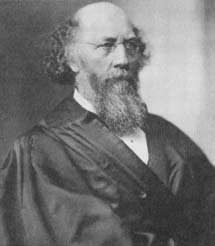Sharon/Hill Divorce And Terry/Field Affair: 1883-1885 & 1887-1890
A Fateful Train Ride
On August 14, 1889, the Terrys were on a train from Fresno to San Francisco. Unknown to them, Neagle and Field were also on board. At Lathrop, the train stopped long enough that its passengers could have breakfast at a local restaurant. Neagle and Field went in to eat, followed a few minutes later by the Terrys. Althea spotted Field and immediately returned to the train. The restaurant's owner then advised Terry of Field's presence. It is uncertain as to what happened next. According to Field and Neagle, Terry approached Field, violently slapped him across the face two times, and then appeared to be reaching for his famous bowie knife when Neagle jumped to his feet and shot Terry twice. An eyewitness, however, said that Terry did not strike Field, but merely tapped Field on the side of the face to get his attention before Neagle rose and shot Terry. In either case, Terry was dead when he hit the floor. No weapon was found on Terry's body.
As a crowd gathered, Field simply stated that "I am a justice of the Supreme Court of the United States. My name is Judge Field. Judge Terry threatened my life and attacked me and the deputy marshal has shot him." Field and Neagle returned to the train and were on board as it left Lathrop.
Both Field and Neagle were arrested for murder, but Field was quickly released after posting a $5,000 bond. Within a week, political pressure led to the dismissal of the charges against the justice, but the local authorities intended to prosecute his bodyguard. Neagle applied to the federal courts for help. When the U.S. Circuit Court in San Francisco heard the matter, Field was in the courtroom mingling with the witnesses. He was also frequently seen with the presiding judge, Lorenzo Sawyer, whenever the court recessed for lunch or for the night. On September 16, 1889, after a lengthy comment on Terry's "life-long habit of carrying arms," "his angry, murderous threats," "his demoniac looks," and "his stealthy assault upon Justice Field from behind," Sawyer ordered Neagle's release on the grounds that he shot Terry in the line of duty.
 Stephen Johnson Field, U.S. Supreme Court justice arrested for murder and later released.
Stephen Johnson Field, U.S. Supreme Court justice arrested for murder and later released.
Thomas Cunningham, the sheriff of San Joaquin County, California, appealed Sawyer's decision to the U.S. Supreme Court. (Lathrop, where Terry was shot, is in San Joaquin County and it was in Cunningham's jail where Neagle was held after his arrest.) G. A. Johnson, the attorney general of California, was one of the attorneys who presented Cunningham's case. Among those opposing Johnson were the Attorney General of the United States, William Henry Harrison Miller, and Joseph Choate, the country's most famous lawyer and a friend of Justice Field.
Cunningham's entire appeal centered on whether Neagle acted in pursuance of the law when he shot Terry. In 1889, there was no federal statute authorizing security for judges and Neagle's appointment as Field's bodyguard was based solely on a letter from Miller to U.S. marshal J. C. Franks instructing Franks to take steps to protect the judge. The argument was made that this letter alone could not keep Neagle from being indicted for murder. However, on April 14, 1890, in a split six-two decision (with Justice Field abstaining), the Supreme Court held that "any duty of the marshal to be derived from the general scope of his duties under the laws of the United States is 'a law' with the meaning of the phrase." Therefore, since it was within the general scope of Franks' duties to protect Justice Field, then Neagle, as Franks' appointee, was acting "in pursuance of a law of the United States" when he killed Terry. Field's bodyguard was now a free man.
There was one final chapter in the story. Althea Terry still faced federal criminal charges arising from the September 1888 incident before Justice Field. The case went to trial in November 1890, but it ended in a hung jury. Her mind started to go, however, and on March 2, 1892, she was found insane by a state court and committed to an asylum, where she died 45 years later.
—Mark Thorburn
Suggestions for Further Reading
Buchanan, A. Russell. David S. Terry of California: Dueling Judge. San Marino, Calif.: Huntington Library, 1956.
Lewis, Oscar, and Carroll D. Hall. Bonanza Inn. New York: A. A. Knopf, 1939.
Lipsky, Eleazar. The Devil's Daughter. New York and Des Moines, Iowa: Meredith Press, 1969.
MacCracken, Brooks W. "Althea and the Judges." American Heritage (June 1967): 60-3, 75-9.
Swisher, Carl B. Stephen J. Field. Craftsman of the Law. Rev. ed. Chicago: University of Chicago Press, 1969.
Additional topics
- Sharon/Hill Divorce And Terry/Field Affair: 1883-1885 1887-1890 - Suggestions For Further Reading
- Sharon/Hill Divorce And Terry/Field Affair: 1883-1885 1887-1890 - Pandemonium In The Courthouse
- Other Free Encyclopedias
Law Library - American Law and Legal InformationNotable Trials and Court Cases - 1883 to 1917Sharon/Hill Divorce And Terry/Field Affair: 1883-1885 1887-1890 - A Secret Marriage, A Long String Of Trials Begins, Senator Sharon Dies, But The Trials Continue